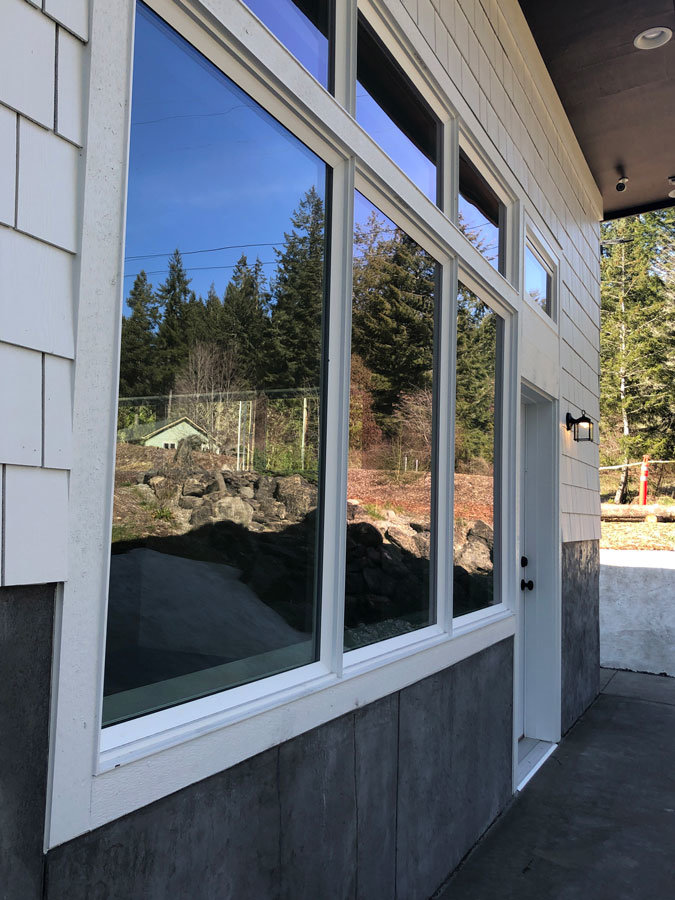
The Key Peninsula is no stranger to the work of dreams, innovation and unconventional thinking, and the latest example is a new house built on Rocky Bay.
The 2,000-square-foot three-bedroom, two-bath home is a simple rectangle with a flat, single pitch roof, but is in no way simplistic.
It’s made of insulated concrete forms — foam blocks locked together and then filled with concrete — to create 14-inch thick exterior walls that are naturally insulated against weather and sound, and have a seismic rating that dwarfs comparable structures.
The owner, Key Peninsula resident Terence King, runs Macnak Construction, the company that built the house. He founded the company in 2008 and until recently has done mostly federal contracts for the Department of Defense.
That’s how the idea for this house originated.
“DOD was looking for an antiterrorism force protection building that could meet its blast-frag resistance requirements — a blast within 40 feet of a building that preserves the occupants,” King said. “What we were building at that time were steel stud buildings” wrapped in a second wall; essentially two buildings. “Those were very expensive, and we still had to insulate them,” he said.
“So we started looking for a product that was faster to build that still met the requirements, but that was more energy efficient. ICF was 50 years old and had been written off, but because of the advances in foam and the lining plastics, the forms had come far enough along that a lot of the early issues were solved.”
“These are essentially big, foam Lego blocks,” said Mitch Baltazar, IT director and residential project manager for Macnak. “A team of three guys can stack a 2,000 square foot house within a week, tie in the rebar, pour the concrete in a few hours and you’ve got solid walls.” Because of the strength of the outer walls, there is no need for interior load-bearing walls, further simplifying design and construction, and reducing cost.
“The big benefit is this is a 100-year wall as opposed to a 30-year wall you’d get with wood,” he said. “You’ve got 3 inches of foam, the center portion can be up to 8 inches of concrete, with rebar for strength, and then you’ve got another 3 inches of foam on the other side. Then there’s a vapor barrier on the outside to seal it off.” Interior drywall and exterior siding can then be attached directly to the foam surface.
“There are no organic materials in it, it’s completely recyclable, it can go through a flood — you can have the thing underwater, it’s not going to mold, it’s not going to break down,” King said. “You can’t hear cars go by, you can’t hear planes; you could be in a thunderstorm and not even know it.”
The Rocky Bay property is a secluded waterfront lot but also right on State Route-302, which made it almost ideal for ICF construction.
“One of the issues is the lot isn’t that deep,” Baltazar said. “With a traditional stick-built home there you’d be battling the road noise, but with ICF not only is it thermally efficient, the sound proofing makes the interior dead silent.”
King and his company started experimenting with different approaches to ICF in 2015 and have completed seven private projects, including custom homes, shops and industrial buildings. They plan to start more projects with the client, designer and contractor working together from the beginning.
In the meantime, King plans to do some landscaping and buy some paddle boards, and to keep the Rocky Bay house as a nightly rental starting this summer.
UNDERWRITTEN BY THE FUND FOR NONPROFIT NEWS (NEWSMATCH) AT THE MIAMI FOUNDATION, THE ANGEL GUILD, ADVERTISERS, DONORS AND PEOPLE WHO SUPPORT INDEPENDENT, NONPROFIT LOCAL NEWS